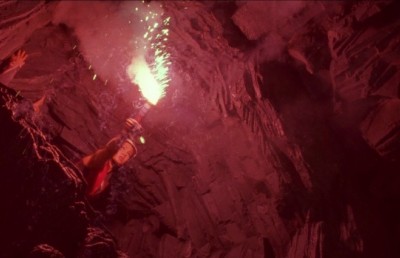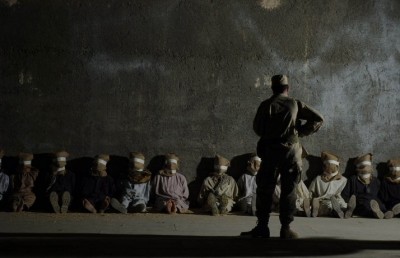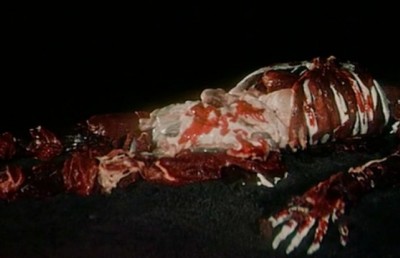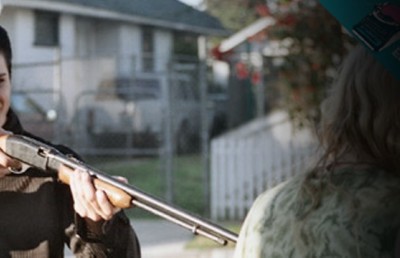An Interview with Sion Sono
Strange Circus
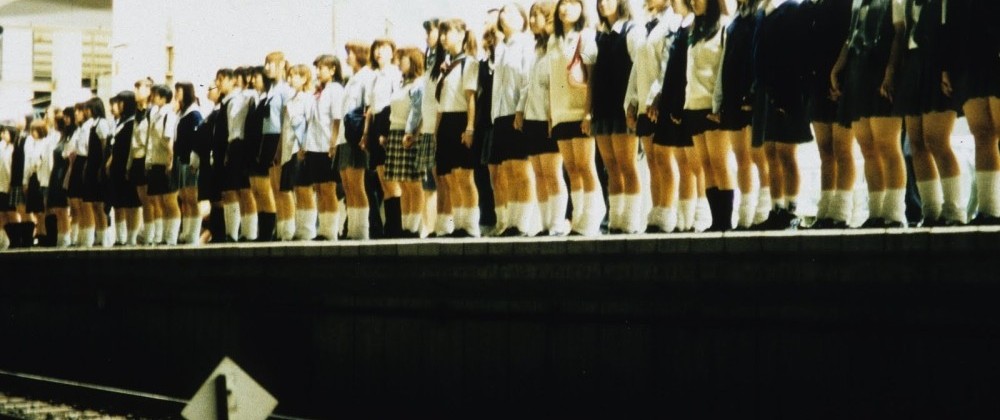
Japanese director Sion Sono presented his feature film Strange Circus at the 2006 Fantasia International Film festival. Sono is no stranger to Fantasia, as his 2002 film The Suicide Club was one of the hits of the festival two years ago. Although The Suicide Club was a strange puppy, Sono ups the ante with his latest film, which was one of the weirdest entries at this year’s festival (and if you are at all aware of Fantasia, that is saying an awful lot!). Strange Circus begins bizarrely enough detailing the incestuous goings on between a father (Gozo, played by Hiroshi Oguchi), mother (Sayuri, played by the great (Masumi Miyazaki), and 12-year-old daughter (Mitsuko, played by Rie Kuwana). The father has strange sexual habits which include placing his daughter inside a cello with a strategically placed peephole and then making love to his wife while the daughter looks on from her enclosed, front row seat. As if this wasn’t strange enough, the father switches the scenario by placing his wife in the cello and makes love to his daughter! Sayuri seemingly dies in a fall down the house’s long staircase, at which point the daughter begins to think she is the mother. These domestic scenes are framed by Felliniesque theatrical scenes at a transvestite/transsexual night club, a setting from which the film gets its title. At roughly the half-way mark we are introduced to other characters, a wheelchair bound writer Taeko (also played by Masumi) and her unstable fan/assistant Yuji (Issei Ishida). During a meeting between Taeko and her editor (Tomorowo Taguchi) it is revealed that all we have seen thus far is material from an erotic novel that Taeko is currently writing. Or is it? Yuji begins to investigate Taeko’s past and discovers overlaps between her novel and her domestic past. The androgynous looking Yuji then reveals that he/she is in fact Sayuri’s (or Taeko’s?) daughter Mitsuko (Yuji exposes wound marks on his chest, which implies that he had his breasts surgically removed.) Man or women, Yuji becomes completely unhinged, confining Gozo to a bed, and using a chainsaw to turn him into a limbless amputee. However, once the porous line between reality/fantasy, fiction/metafiction is shattered it becomes clear that we can not trust what we see, who is who, or what a character tells us. As Yuji himself says in the film’s final line of dialogue, “What’s real; and what’s not?”
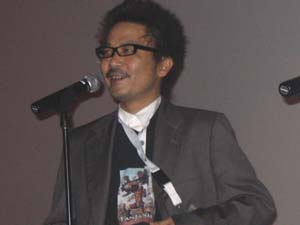
Offscreen: I know that your background is in poetry. So how do you go from poetry to filmmaking? Do you see any similarities between your poetry and filmmaking?
Sion Sono: I wanted to change from the word to something else. In poetry you always have the written word that is printed. When you are angry or sad it is a bit different when you are writing the emotion because the emotion can appear in the handwriting but not in a printed type. I wanted to keep in my mind the type of emotions I might have had with my hand writing so I began to film my poetry, like writing on a wall and filming it. I would do that on the street and try to maintain the emotion of the handwriting.
Offscreen: That is a very interesting because in our language writing is not very visual whereas in Japan and China, where you have calligraphy, it is very different. In fact there is a very famous Russian filmmaker named Sergei Eisenstein who studied haiku poetry to help him with his montage theories, which may or may not be relevant. But to get back to the idea of poetry, you often hear of certain filmmakers referred to as being poetic, like Tarkovsky for example, or John Ford. So I am just curious about how you would define a poetic film maker, or the sort of things you may look for in such a director?
Sion Sono: Well, the starting point was that I want to make a poetic, artistic type of film. I wanted to use film as the tool with which to express myself to the audience, and so I started to change the style of my film to suit this.
Offscreen: I’m not too familiar with the ero-guro (“erotic grotesque nonsense”) tradition or the writer Edogawa Rampo, so maybe you can talk a bit about whether they are influential on your work.
Sion Sono: Rampo is my favorite author.
Offscreen: Yes, well the actress Miyazaki Masumi, who was in Akio Jissoji’s The Mystery of Rampo (Rintaro Mayuzumi, Kazuyoshi Okuyama, 1994), is in your film. Is that one of the reasons why you used her?
Sion Sono: It was my boss the producer who hired her (laughter). But I did ask the producer if I could make a film with her.
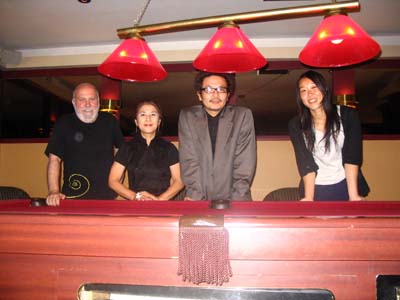
Offscreen: Somebody once said that ero-guro is half beautiful and half grotesque, so I assume Masumi would be the beautiful aspect of the film? In other words, the film is supposed to be very beautiful but also very horrible.
Sion Sono: Yes you can say that, but it is not only black and white like that. Maybe in her character there is an ‘ero-guro’ side and in the beauty there is a grotesque side. If she is beautiful it will allow you to see the grotesque side more because of the contrast.
Offscreen: I’ve noticed in the few of the ero-guro films that I’ve seen that there seems to be a fascination with boxes. The Takashi Miike story in Three Extremes is called “The Box.” In The Mystery of Rampo there was this little animation film before the live action that deals with a woman who suffocates her husband in an heirloom chest; and in your film you have the cello which functions like a box. Although not a ero-guro film, there was a Japanese film that played here two years ago named The Bottled Fool by a young Japanese director named Hiroki Yamaguchi. It is about a group of people who are stuck in this freight elevator, so the freight elevator itself also functions as a box containing all the people. I am wondering whether you can elaborate on this idea of the box?
Sion Sono: If it occurs often in these films I would say it is Japan. It represents Japan. Japan is an island and it is kind of isolated from other places so I can see it as a symbol for Japan.
Offscreen: I don’t think I ever heard that before.
Sion Sono: Of course it does not mean that we have to be actually in a box, but that we as a nation do not have different ideas. We have an idea that we get stuck into. I think that Japan and Japanese society in reality is a very humid country and our ideas are ‘humid,’ they are not ‘dry.’ I’ve been actually thinking of making another film entitled “The Box.”
Offscreen: I want to ask you about the art direction. Inside the Masumi family house it looks almost normal, especially to us because it is very Western European style house, but in the setting where she works as a writer it is completely fantasized and grotesque. As well, the house where she lives becomes fantastic when it becomes red or yellow, when it changes color. It seems only when we are outside on the street that things look normal. Can you talk a little bit about the style of the art direction, in terms of reality and fantasy? Or maybe to make the question more specific: last night when you presented the film you said that the color white could represent reality and the color red fantasy. Can you just elaborate on how you use those colors to negotiate between reality and fantasy. I know it is never clear…because we are also thinking about internal and external, like, for example, everything inside is subjective.
Sion Sono: Yes you can say that the outside is the reality and inside is the internal, the more subjective.
Offscreen: How did you achieve the saturation of the colors?
Sion Sono: I did do some manipulation in post-production. I did not use any CGI. We also did some painting of the sets.
Offscreen: You had sets that were red, yellow or white. Did you use the same set repainted or did you have different sets?
Sion Sono: We used the same set and changed it.
Offscreen: You also wrote the music for the film. Do you play an instrument?
Sion Sono: Yes I play keyboards.
Offscreen: So you composed the music on the keyboard.
Sion Sono: Yes.
Offscreen: That is a lot of work, to write, to direct, to compose. But you did not act in it, although I know you acted in other films too.
Sion Sono: Well, I would have wanted to act too!
Offscreen: I remember when I read about The Suicide Club that you were thinking at that point of making three films that were connected. Is this film part of a trilogy with The Suicide Club & Noriko’s Dinner Table?
Sion Sono: This film does not have anything to do with the other two. I always wanted to make a trilogy but in reality it is very difficult.
Offscreen: How long was the shoot?
Sion Sono: Twenty days.
Offscreen: That is amazing. Another production question which relates to one of the film’s themes, identity. In the story you have the switching of the mother for the daughter in the cello watching the lovemaking, where first it is the daughter in the cello looking at her parents making love, and then the father switches and puts the mother in the cello and makes love to the daughter. But from the audience’s perspective we still see the mother, the actress Masumi. Obviously that is largely because you could not have had a man making love to a young girl, and yet it also works as part of the film’s theme of confused identity.
Sion Sono: I did not want to force things but if there was a way that I could have shot her, or if society would not have reacted against that I would have used the girl. If the girl would have been old enough to have had a sexual experience, then I would have used her.
Offscreen: I thought it was very clever having that slippage from the daughter to mother, but I am amazed that TLA has picked up this film for North American distribution because one of the biggest taboos in North America, actually the biggest taboo in North America, is pedophilia. Even if you are not using children but just having that situation it is a bigger taboo than incest even.
Sion Sono: Well this is really not a pedophilia film at all.
Offscreen: O yes, I’m not saying that, but the sensors in North America look for these things and don’t make a distinction between a sophisticated film that is dealing with it as a subject and a pornographic film. That is why I am surprised that a distributor has picked it up, but that is great. Along with that we have had a lot of American remakes of J-Horror, but I don’t think there has been a remake of an ero-guro film, and that is probably because it would be too problematic, with the ero-guro mix of sex with violence. I think in a way that is a good thing. It is a way for you to protect your film, because you know they won’t ever remake your film.
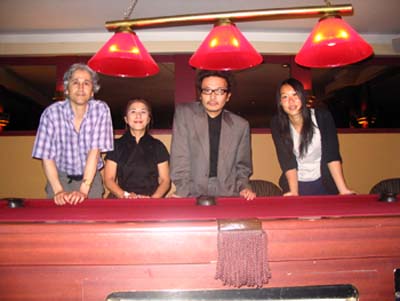
Offscreen: Again I think the film is very sophisticated in this way, but there are parts of the film that are comic and parts that are serious. I thought the first part of the story up until the part where the girl is to be guillotined, because she wants to die, was very serious. And if it had been funny, it might have been a problem but other parts of the film were funny and it was OK. Did you know which sequences you wanted as comic and which as serious? Was it difficult to switch from comic to serious?
Sion Sono: I think film has the power to make audiences realize that if you are alive you will have painful experiences, and you’ll get hurt. Showing the audience that you can laugh about it helps audiences laugh at their own pain or sorrow as well. I don’t want a film to go too deeply into terrible experiences or a person’s sorrow, but a shifting and balancing between them.
Offscreen: As well, I think it is clear to me that the father figure is pretty despicable. From start to finish there is nothing likable about him, he is a caricature, which is good because then no one will identify with the father. Whereas the mother and daughter are complex characters. And we are inside their heads throughout the film. I really like that aspect. If the father was a fully rounded character like the mother and the daughter then it might have been a problem.
Sion: That is exactly what I intended to do with this character. People really do not share his view, but at the same time he was a symbol of the most disgusting part of man, an aspect that people do not want to see, that is why you make him into a clown and you can laugh at him.
Offscreen: This is more of a statement than a question. What I like most about the film is the shifting of realities to such an extent that we do not know what in the film was dream and what was reality. And then in the end maybe everything is a dream. This reminded me of something my father once said to me when I was a child, that he wondered himself what the real world was, and that maybe the real world is what we have inside our heads when we sleep and what we live when we are awake is actually ‘unreal.’ This film made me think about that. It refuses to allow us to understand what is a real and what is fantasy.
Offscreen: Another way of looking at it, because the film has a story within a story structure, with the Masumi character (Taeko) as the writer of the story, is that we are seeing her imagination. It could also be a film about the creative process, something like Barton Fink for example. Or a little bit like 8 ½ where you see the creative process of a director who we see trying to make a film. In this film we have a writer who we learn is trying to write a story, and we are seeing the story which we think is fiction but then it becomes metafiction, a fiction inside of a fiction. We can never see inside the artist’s mind but the film is an idea of what it would be like inside an artist’s mind.
Sion: No, it is not only the writer here or the director, but everyone. It can be anyone’s mind. I do not care what is inside the writer’s mind but I am interested in everyone’s creativity. Everyone has a creative side which is of interest to me.
Offscreen: I’m curious because yesterday when you introduced the film you said the Japanese do not like this film. I wonder if it is because of the Western aspects to the film, especially thematically in terms of the psychology. And with some of the settings, like the circus, there is a lot we can relate to as Westerners. Is it perhaps too Western for Japanese audiences?
Sion: Well I guess you could say that I intended to make the film not as an easy film to be liked!
Offscreen: Are there any films that influenced you?
Sion Sono: Paul Verhoeven’s Showgirls is the best!
Offscreen: Wow, that’s very interesting! What about Kenji Fukasaku, for example Black Rose Mansion which features a transsexual man playing the part of a woman, who is always performing. It has a lot of theatricality, like your film. The circus sequences in your film reminded me a bit of this film.
Sion Sono: I am honoured that you make these connections.
Offscreen: I thought of another weird parallel. There is a record by the band, The Doors, with Jim Morrison, entitled Strange Days, where there are images of circus people on the album cover, a weightlifter, a mime, and your film reminded me of this image. And there is a song from this album called “People are Strange,” which describes the people in your film well! Do you know this album?
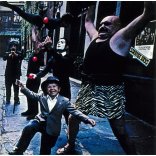
Sion Sono: Yes I know The Doors.
Offscreen: I guess it is a nice coincidence, then. Some people who may live in different parts of the world and come from different cultures can think the same way. Their ideas are similar…and Jim Morrison started as a poet too!
Many, many thanks to interpreter Serina Nishioka.




